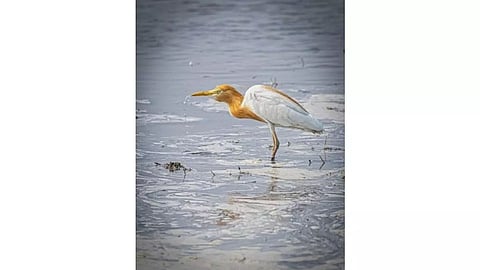
- Home
- Live Blog
- Breaking News
- Top Headlines
- Cities
- NE News
- Sentinel Media
- Sports
- Education
- Jobs

Monsoon is here and Everything is so green and fresh. Earth seems much more beautiful, and lively. Amidst this greenery, imagine slender birds with orangish — golden plumes on the back, breast and crown with a bright red bill — all this dressing up is for pairing and breeding. So much so, that bill colour change happens for the short three-four days pairing period!
The cattle egret looks more beautiful with its buff feathers all blowing delicately in the breeze — adding a romantic feel to the whole atmosphere in the rainy season.
Monsoon is the breeding season where their coloration changes, their feathers turning a russet orange on the bird's head, neck, chest, and back. The intensity and placement of their coloration varies by subspecies. The cattle egret's beak also transforms into a sherbet-inspired rainbow, from yellow at the tip, blending to red, and then purple-pink around the bird's lores and eyes.
This beautiful white bird adorned with golden buff plumes during the breeding season appears in a totally different look in the monsoon season. This is their nesting time too.
As the name suggests, this widespread resident in India, is commonly found around cattle feasting on the insects disturbed by the grazing mammals. Grasshoppers are its preferred food but it does not mind frogs, toads, lizards and other small mammals. Sometimes you can find them riding on cattle eating parasitic insects as well. In India it is also known as "tick bird". It's a familiar sight, and most birders don't think twice when they see a cattle egret lurking in a herd's wake.
But these unassuming little egrets are downright impressive. In the past 150 years, cattle egrets have self-populated nearly every continent on earth. Just how, and why, remains somewhat of a mystery. Because of their rapid range expansion, cattle egrets are sometimes classified as invasive.
Researchers call the cattle egret a cosmopolitan species of the heron family found throughout the tropics, subtropics and warm temperate zones of the world. Due to its close relationship with humans and their cattle, the cattle egret has undergone one of the most wide-reaching expansions of any bird species in the world. Anywhere livestock owners — from nomadic herdsmen to today's massive agri-business operations — moved, cattle egrets followed closely behind. This species has a long relationship with humans and is symbolic in many cultures.
In Hindi it is known as Bagula and in Indian culture, known for calm, determination, observation, silence, solitude, tranquility, independence, partnership and grace. In Africa, the egret was thought to communicate with the Gods. In China, people see the Bird as a symbol of purity, long life, strength, and endurance. Similar feelings exist in Japan with the addition of the Egret representing nobility, devotion, and a graceful spirit. In Greek culture, the Egret is Athena's messenger: The Goddess of Wisdom. People would interpret its crackling shriek as an omen that the Goddess was watching over someone, sailors in particular.
In the world of spirituality, it says that the egret wants you to learn patience. There are many situations in your life you can't force. Often, being anxious leads to making the wrong choice. One of egret's lessons involves learning how to stand quiet and watchful while applying restraint until the perfect situation reveals itself. (IANS)
Also Watch: